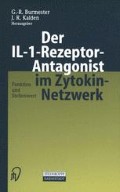Zusammenfassung
In diesem Kapitel wird auf einen Antagonisten des IL-1 fokussiert, dessen klinische Prüfung für die Anwendung bei der rheumatoiden Arthritis weitgehend abgeschlossen ist und dessen Zulassung zur klinischen Anwendung in Kürze erwartet wird. Es handelt sich um den in den Laboratorien der AMGEN Inc., Thousand Oaks, CA, USA, rekombinant hergestellten, natürlich vorkommenden IL-1-Rezeptor-Antagonisten (IL-1ra, Anakinra). IL-1Ra gehört zur IL-1-Gen-Familie, die aus den Agonisten IL-lα und IL-1β sowie ihrem Rezeptor (IL-1R) besteht. IL-1Ra ist das dritte Mitglied dieser Genfamilie und verantwortlich für die Regulation von IL-lα und IL-1β durch hochavide kompetitive Bindung an den Typ-1-IL-1R [1]. IL-lβ und IL-1Ra sind bei rheumatoider Arthritis regelmäßig in der Synovialflüssigkeit nachweisbar. Klinische Beobachtungen bei Lyme-Arthritis weisen darauf hin, dass das molare Verhältnis von IL-lβ und IL-1 Ra in der Synovialflüssigkeit mit dem Schweregrad der Arthritis korreliert. In einer 1993 veröffentlichten Studie wiesen Patienten mit der höchsten Konzentration von IL-1Ra die niedrigsten IL-lβ-Konzentrationen in der Synovia und die kürzesten Arthritisphasen auf und vice versa, d.h. das IL-1Ra-IL/lβ-Verhältnis reflektierte die Krankheitsaktivität der Lyme-Arthritis [13]. IL-1Ra muß in vitro in einem 10 bis 100fachen Überschuss zu IL-1 vorliegen, um dessen biologischen Effekt signifikant zu inhibieren [1, 14]. In einer klinischen Studie ist gezeigt worden, dass das spontane Verhältnis von IL-1Ra: IL-1 in der Synovia von Patienten mit rheumatoider Arthritis demgegenüber jedoch nur 1,2–3,6 betrug und demzufolge den Bedarf zur Inhibition der IL-1-Bioaktivität weit unterschritt [9]. Es erschien deshalb wahrscheinlich, dass eine therapeutische Applikation von IL-lra den Krankheitsverlauf bei entzündlich aktiver rheumatoider Arthritis positiv beeinflussen kann.
Access this chapter
Tax calculation will be finalised at checkout
Purchases are for personal use only
Preview
Unable to display preview. Download preview PDF.
Literatur
Arend WP, Welgus HG, Thompson RC, Eisenberg SP (1990) Biological properties of recombinant human monocyte–derived interleukin-1 receptor antagonist. J Clin Invest 85: 1694–1697
Arnett FC, Edworthy SM, Bloch DA et al (1988) The American Rheumatism Association 1987 revised criteria for the classification of rheumatoid arthritis. Arthritis Rheum 31: 315–324
Bresnihan B, Alvaro-Gracia JM, Cobby M, Doherty M, Domljan Z, Emery P, Nuki G, Pavelka K, Rau R, Rozman B, Watt I, Williams B, Aitchison R, McCabe D, Musikic P (1998) Treatment of rheumatoid arthritis with recombinant human interleukin-1 receptor antagonist. Arthritis Rheum 41: 2196–2204
Bresnihan B, Chan WW, Woolley JM (2001) Anakinra (IL1 RA) increases days of work and domestic activity in patients with rheumatoid arthritis. EULAR 2001, Poster SAT 0242, Prague, June 13–16, 2001
Campion GV, Lebsack ME, Catalano M and the IL-1 RA Arthritis Study Group (1996) Dose–range and dose–frequency study of recombinant human interleukin-1 receptor antagonist in patients with rheumatoid arthritis. Arthritis Rheum 39: 1092–1101
Cohen S, Hurd E, Cush J et al (2001) Treatment of rheumatoid arthritis with recombinant human interleukin-1 receptor antagonist in combination with methotrexat. Arthritis Rheum in press
Emery P, Wolley JM, Chan WW (2001) Improvement in health-related quality of life from Anakinra therapy in patients with rheumatoid arthritis not using DMARDs. EULAR 2001, Poster FRI 0041, Prague, June 13–16, 2001
Felson DT, Anderson JJ, Boers M et al (1993) The American College of Rheumatology preliminary score set of disease activity measures for rheumatoid arthritis. Arthritis Rheum 36: 729–740
Firstein GS, Boyle DL, Yu C et al (1994) Synovial interleukin-1 receptor antagonist and interleukin-1 balance in rheumatoid arthritis. Arthritis Rheum 37: 644–652
Jiang Y, Genant HK, Watt J, Cobby M, Bresnihan B, Aitchison R, McCabe DA (2000) Multicenter, double - blind, dose-ranging, randomised, placebo-controlled study of recombinant interleukin-1 receptor antagonist in patients with rheumatoid arthritis. Radiologic progression and correlation of Genant and Larsen score. Arthritis Rheum 43: 1001–1009
Kalden JR (2001) How do the biologics fit into the current DMARD armamentarium? In: Emery P (ed) Evolving concepts in the treatment of rheumatoid arthritis. J Rheumatol [Suppl 62] 28: 27–35
Lebsack ME, Paul CC, Bloedow DC et al (1991) Subcutaneous IL-1 receptor antagonist in patients with rheumatoid arthritis. Arthritis Rheum [Suppl] 34: 67
Miller LC, Lynch CA, Logan IS, Donarello CA, Steere AC (1993) Balance of synovial fluid IL-lß and IL-1-receptor antagonist and recovery from Lyme arthritis. Lancet 341: 146–148
Seckinger P, Klein-Nulend J, Alander C, Thompson RC, Dayer JM, Raisz LG (1990) Natural and recombinant human IL-1 receptor antagonist block the effects of IL-1 on bone resorption and prostaglandin production. J Immunol 145: 4181–4184
Editor information
Editors and Affiliations
Rights and permissions
Copyright information
© 2002 Springer-Verlag Berlin Heidelberg
About this chapter
Cite this chapter
Kaltwasser, J.P. (2002). Wirksamkeit und Sicherheit von rekombinantem IL-1-Rezeptor-Antagonisten bei Patienten mit rheumatoider Arthritis. In: Burmester, GR., Kalden, J.R. (eds) Der IL-1-Rezeptor-Antagonist im Zytokin-Netzwerk. Steinkopff, Heidelberg. https://doi.org/10.1007/978-3-642-53780-6_5
Download citation
DOI: https://doi.org/10.1007/978-3-642-53780-6_5
Publisher Name: Steinkopff, Heidelberg
Print ISBN: 978-3-642-53781-3
Online ISBN: 978-3-642-53780-6
eBook Packages: Springer Book Archive

